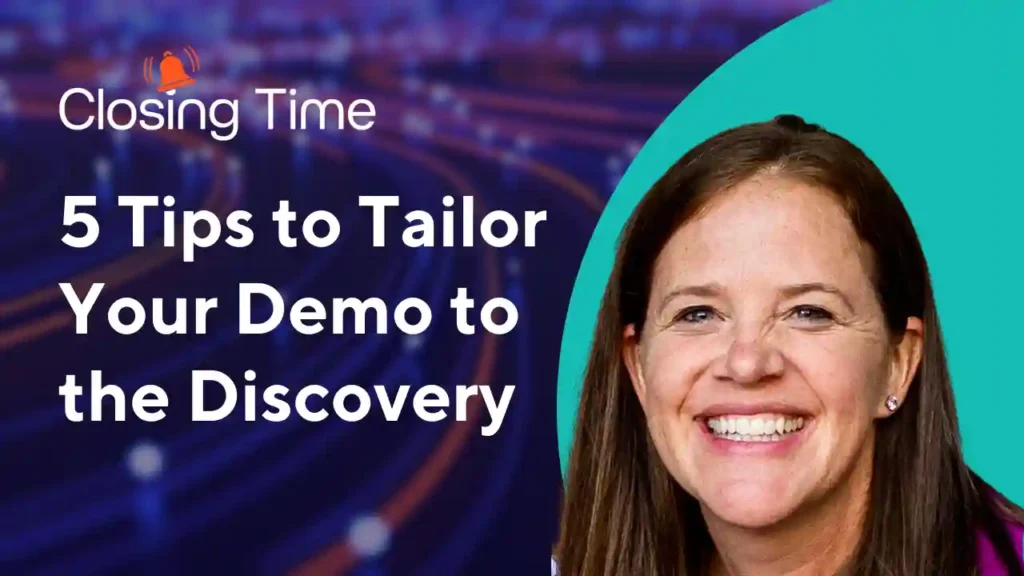If I started this video with a compelling story, chances are you’d watch the whole thing. We’re talking all about storytelling in marketing and sales on this episode of Closing Time. Hi, I’m Val Riley, head of content marketing at Insightly. welcome to Closing Time, the show for go-to-market leaders. Today, I’m joined by Ravi Rajani. He’s a speaker, storyteller, and communications trainer. He’s also host of the Influential Communicator podcast Welcome to the show, Ravi. What’s happening, my friend?. Good to be here. Good to be here. Hey, Ravi, let’s get right into it. One distinction I have heard you make is that a case study is different from a customer success story. Confession, i’ve used those terms interchangeably in my career. Can you set me straight? Yeah, OK. I think a lot of people do, right? We’ve all been there, done that and worn the t-shirt. But I think the best way to describe it is, Val, when was the last time you went to a shopping mall? Oh, gosh, couple of weeks, maybe. OK, a couple of weeks. And did anybody come up to you saying, hey, miss, would you like to try some of our cookies, like a little sample? Did anybody do that? Yeah, it was a hair care product, actually. Oh, really? OK, now imagine the customer success story being the sample of the haircare product. You try and you like Oh, actually, I’ve had a taste of what this product could feel like. Now, let me go into the store, check out the ingredients, see if it’s really a good fit for me and the problem that I want to solve. So I see a customer success story as their hair sample, and I see the case study as the juice, the meat, where you go really tactical and in depth. And that’s when you walk into the store and you really take a look at whether this product could be a fit for you. OK, so let’s talk about storytelling tips because you know, as marketers, as communicators, as salespeople, we know stories are compelling and everyone loves a good acronym and you’ve got one, ACORN. So what is it and what does it mean? Yeah, I’m obsessed with ACORN. So for those of you listening to this right now who are familiar with my work, you’ll know I basically talk in acronyms. But I digress. So a dude called Ralph Emerson, he once said that the creation of a thousand forests is in one acorn. And Val, here’s what I believe. I believe that the creation of a thousand connections in relationships is in one story so what does ACORN actually stand for in terms of an acronym? Well, A stands for attention grabbing, meaning your story must be attention grabbing. Here’s what I mean, Val. Last year I got married in October, and I remember I was like, I’m going to get in the best shape of my entire life. So I hired this personal trainer and I was going for gold. Every single day, I would go to the same gym at same time at around 8 a.m.. And I remember I would sometimes get to the gym, Val, and I had no idea how I even got there because I was doing the same journey every single day. It was predictable. Then one weekend, my wife says, Rav why don’t we go visit the spa down the road? You can go to the gym, we can go for a swim and hang out. And I was like, Yeah, you know what? Cool, let’s do it. We jump in the car, my phone dies when it comes to the battery, and I don’t know where I’m going because I haven’t been there before and I’m a bad driver, Val, so I’m up against the wheel, right? Like that, thinking,. Oh my God, where am I going? And I was paying attention because the journey was unpredictable. So that’s one way to ensure that you’re grabbing your customers attention by having an effective hook to your story. All right, so that’s the A, let’s move on to the C. So when it comes to C, Val, we’re talking about a story containing a relatable main character. And this is so that your audience, your prospect can really see themselves in the pains, in the desires and the transformation of your main character. Now, here’s one way to think about it, Val. You can have the most amazing story, but it could be a poor fit for the person that you’re speaking to. So you have to remember that the individual who’s the main character inside of your story, it should be somebody who has a similar DNA, pain, big underlying root cause problem, and a desire is the person you’re trying to connect with. Because as human beings, we’re thinking, you know what? Who’s somebody just like me? Who’s been in my shoes, who has gone from pain to glory because I want to be just like them. Right? So your story must contain a relatable and clearly identifiable main character. Right? OK, so if I’m hearing you correctly, it’s that ideal customer profile. ICP is the main character of the story. Right? Exactly. Know exactly who you’re speaking to. Got it. OK, all right. Let’s move on to the O. So when it comes to O, what we’re talking about here is that your story should organically unfold within a simple story arc. Now, I don’t know. I don’t know about you rather, Val, I’ve got a lot of friends who are like, yo, Rav,. I’m going to tell you this story. You’ll never guess what happened on the weekend. And I’m a sucker for a good story, so I’m like, OK, Cool, I’m going to listen in, 10 minutes later, I’m like, there was a beginning. There was kind of a middle. There was kind of an end. The story actually added no value to my life. Yeah. I just wasted 10 minutes of my life. I don’t tell them because I’m polite, but that’s what I’m thinking in my head. So when it comes to your prospects, you want to ensure that your story is easy to follow because attention is the currency. We don’t want to lose that. So if I showed you a story arc, which a lot of people resonate with today, it would probably overwhelm you. And the story arc that I’m talking about is the hero’s journey. Now, that’s amazing for movies. For books, for longer form content, for two day workshops or whatever it might be. But the steps inside of that arc can be quite overwhelming if you’re just trying to share a story on the fly with a prospect in less than 90 seconds. So here’s what I want everybody to think about, you listening to this right now. Think about these four key elements within a story arc: Context, conflict, turning point, transformation. I’m going to repeat that context, conflict, turning point, transformation. Now, the context is where you introduce your main character with time, date, setting. You got to let people know where the story begins, OK? And then that character, the main character of your story, stumbles upon an obstacle a.k.a the conflict. And then the turning point is where they have that aha moment. Like, what was the name of that scientist? Was it Isaac Newton, who is sitting under the tree and had that apple fall on his head. I think it was right. But you have the Isaac Newton moment. What was that moment where the apple fell on your head and you were like, Ah ha, and that moment began the transformation, which leads to the final element, which is the transformation of your story. Think about how your main character goes from pain to glory, and especially in the glory, a.k.a in the transformation. Think about time, money and energy. How did your main character save or make more money? How did they create more time and save time? And how do they gain and conserve more energy by going from pain to glory? Now the goal here is, one, for the prospects and the audience to feel seen, heard and understood, and see themselves in the journey of the main character. And through that, if you do that effectively, what will happen is you will be seen as the Yoda, right? You will be seen as the Yoda, the guide. You don’t need to be the hero, right? Your prospect is. The person in your story is. But the idea is if you build enough trust and if done effectively, you will be seen as a potential guide to take the person you’re talking to from pain to glory. I feel like I should talk like Yoda right now because that would just be fun. But I really like how you emphasize simplicity because especially in some of the SaaS solutions that we’re selling, you know, these are complex products and services, but we have to keep it simple. And so we don’t confuse the prospect.. Right. Exactly. Exactly. And like I said, the case study is for me where a lot of the technical information will lie. But you’ve got to think about it. Go back to the hair sample. Somebody needs to taste their hair sample and go, Oh, this is intriguing. So they’ll walk into the store and give you more of their time to learn more about whether this is a great fit for them. Now, I don’t know about you, but when I’ve been in the shopping mall, I try a cookie. I’m like,. I don’t really have the time. The moment I take a bite, I’m like, OK, let me go buy five boxes. Right? So remember, this story is where the emotion lies. The stories that grab their attention. Then you’ve got to learn how to keep it and ultimately solve their million dollar problem. OK, so the next letter is where it gets good because we’re going to talk about the bad guy. The villain, right? The villain. So R stands for revealing the villain. OK, your story must reveal the villain. Now, what you got to remember here is that a story without conflict or tension, does that really engage a buyer? Think about the best movies in the world. They’ve all got a villain, right? Let’s take Disney, for example. Back in the day when I was a kid, I loved. Aladdin. Who was the villain in Aladdin? It was Jafar, and I hated him, Val. I went to Disneyland, and I remember. I was getting everybody’s autograph as a kid. I didn’t want Jafar’s autograph. And he stamped my foot. I was fuming.. I was so angry. I remember that. But I got his autograph.. But I did it begrudgingly. I wanted Aladdin, and I was like,. Where’s Aladdin at? Where’s Jasmine at? I was rooting for the main character because the high levels of tension and when it comes to your story, think about not the pains of your prospect. Think about the underlying root cause of that pain. So, for example, Val,. I’ve hurt my lower back, OK? So I ring up my physio, Louise,. I’m like, Louise, you need to do that thing where you just put my back back into place. Please. She’s like, All right, OK, come to the clinic tomorrow. And we’re going to sort you out. I get there and I’m like literally rushing her just to fix me so I can leave. She says, Whoa, whoa, calm down, Rav. Let’s do a little bit of diagnosis here. And when it came down to it, she said, Rav, your problem isn’t your lower back And I was like, Well, it is because that’s what’s hurting. The pain is actually rooted in the way you walk because of your flat feet. So actually, if we help you realign the way you walk and we strengthen those leg muscles and ankle and foot muscles, then it’s going to really change the way your back feels because there’ll be less load on it. And I was like, Oh, OK, cool. So the million dollar problem for me is my flat feet, right? Always has been. So what is the million dollar problem for your ideal client? Meaning the underlying root cause of that pain, and that is the villain. That’s the villain. All right. So next, we’re going to talk about the N. And this is about nurturing trust. How does that work? So nurture trust, as you said, Val is all about doing just that, nurturing trust. Now, I don’t know about you, but if I had asked my wife to marry me on our first date, she would have said no, she wouldn’t have been having it. Right. So a lot of the times we get excited in sales, we’re telling a story. You say, OK, would you like to book a demo or would you like to buy my product at the end of the story. But what you have to think about is conversion is all about context. For one person, conversion is actually moving to booking a discovery call. For another person, conversion could be moving to the next stage of the sales process where you demo the product further. Or you book some time with the solutions engineer, whatever it could be. So really think about not going from zero to 100 real quick, as Drake would say, you need to go to the next stage of the sales process and ensure it aligns with the buyer’s journey. I like to call those micro yeses. You know, it’s not the big yes, but it’s a micro yes that gets you to towards the big yes. Yeah, exactly. And sometimes a CTA, is just eliciting a response from the person that you’re speaking to. It could be to get them to exchange a story in return. I think, when we think of call to actions, sometimes people feel icky, like, oh,. I have to pitch my product. I mean, that’s all about context, right? If you’re going to do that, it takes a lot of context and self-awareness to understand who you’re speaking to. OK, so we’ve got the ACORN acronym. Can you pull it all together for us now? Yeah, exactly. So now, Val, somebody understands the ACORN checklist for their customer success story. They’ve got their case study, OK? Now they’re going to pivot it into a high converting 90 second customer success story. So what they do is they use the ACORN method to extract all of the juicy bits in accordance with the acronym. But then how do they structure it? Well,. I teach something called the PSA method. Now, a guy called Victor Antonio, amazing dude. He calls it SPA method. Some people who learn this in school as a kid, they call it the PEE method. I call it the PSA method. And very simply,. I’m talking about point, story, audience impact. To share a point with your story, share a great hook, something which grabs their attention, then go into the context, the conflict, the turning point and the transformation but then to ensure that your story is actually contextualized for the person that you’re speaking to, go to Audience Impact. What does it mean for and to the person that you’re speaking to? And inside of that mini framework, what you can do is develop a short, customer success story. Now, some of you might be thinking, Rav,. I can’t do that in 90 seconds. Well, roughly, depending on how fast you talk, that’s around ten lines worth of writing OK. And what you got to remember, in the virtual world, that a lot of us operate in now, less is more. Think like a comedian. They don’t come out and share this eight minute joke to start with. They’re constantly earning your trust, right? They share shorter jokes and then they layer in longer ones as they build more rapport and trust. And with your storytelling, think about it like the same. OK, well, I’m inspired now to do all my storytelling. Thank you so much for that framework. It really is helpful. Thank you, my friend. Appreciate it. All right. Well, that’s all the time we have for this episode of Closing Time. Remember, subscribe to this channel, like the video, and click the bell for notifications so you don’t miss an episode. Take care, everyone.. We’ll see you next time. On Closing Time.





